Best Trees for Front Yard
- December 19, 2023
- 0 comment
When it comes to designing your home’s exterior, the power of a well-chosen tree in your front yard cannot be overstated. Not only does the right tree enhance curb appeal, but it also offers shade, can improve air quality, and even potentially increase property value. But with so many species and varieties to choose from, how do you select the perfect tree for your front yard? This article will guide you through the process, ensuring your yard stands out in your neighborhood for all the right reasons.
Top Trees for Front Yards
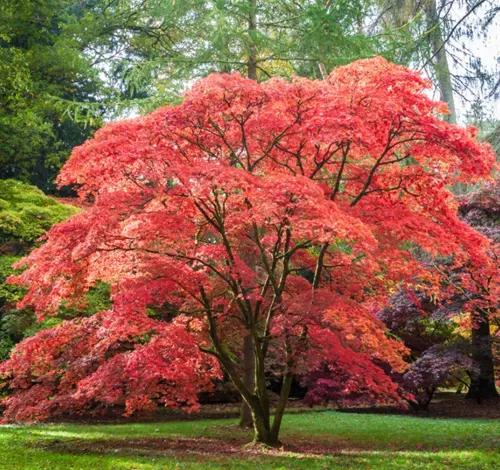
Japanese Maple (Acer palmatum)
This small, ornamental tree is a marvel with its stunning, varied foliage that offers a kaleidoscope of colors and shapes throughout the seasons. Ideal for smaller yards or as a striking focal point in a larger landscape, the Japanese Maple fits well in spaces where a larger tree would be overwhelming. It generally reaches a height of 15 to 25 feet, making it a manageable size for most yards. In terms of care, this tree requires minimal pruning and can adapt to a variety of soil types, though it thrives best in well-drained, slightly acidic soil. It’s suited for USDA hardiness zones 5-8, enjoying partial to full sun exposure.
Dogwood (Cornus species)
The Dogwood tree is celebrated for its beautiful spring blooms and vibrant fall foliage. It’s a medium-sized tree that usually grows to about 20 to 30 feet tall, fitting well under the canopy of larger trees or in open sunlight. This tree is ideal for adding aesthetic appeal and a splash of color to your yard. It prefers well-drained soil and benefits from occasional mulching to maintain soil moisture. With a moderate growth rate, Dogwoods are suitable for zones 5-9 and require some care to protect against diseases and pests.

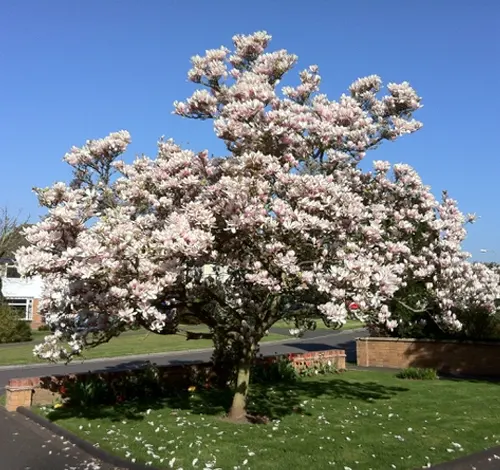
Saucer Magnolia (Magnolia x soulangeana)
Known for its large, tulip-shaped flowers that bloom in the spring, the Saucer Magnolia is a stunning choice for creating a dramatic focal point. It typically grows to about 20 to 30 feet in height and width, making it a suitable option for medium-sized yards. This tree prefers full sun to partial shade and well-drained, slightly acidic soil. It is relatively low maintenance but benefits from occasional pruning to maintain its shape and overall health. Hardy in zones 4-9, it’s a resilient choice for many climates.
Crepe Myrtle (Lagerstroemia)
The Crepe Myrtle is a popular choice in warmer climates, known for its beautiful summer blooms, attractive bark, and vibrant fall color. This tree can vary in size from small shrub-like forms to larger trees reaching upwards of 20 feet. It’s ideal for drought-resistant landscaping and thrives in full sun with well-drained soil. Hardy in zones 6-9, Crepe Myrtles require annual pruning to promote blooming and maintain their appealing shape.


Sugar Maple (Acer saccharum)
Celebrated for its spectacular fall color and as a source of maple syrup, the Sugar Maple is a fantastic option for larger yards, growing up to 40-80 feet tall. It provides ample shade and has a grand presence. This tree thrives in well-drained, slightly acidic to neutral soil and prefers full sun to partial shade. It’s relatively low maintenance and is hardy in zones 3-8, making it a versatile choice for many regions.
Oak (Quercus species)
Symbolizing strength, Oaks are known for their dense shade and robust stature. They are typically large trees, with many species reaching upwards of 60-70 feet or more. Ideal for those looking for a stately, long-lasting tree to anchor their landscape, Oaks have expansive root systems and require ample space to grow. They are generally low maintenance but require minimal pruning to maintain health and shape. Oaks are suited for a wide range of climates, generally hardy in zones 3-9, depending on the species.
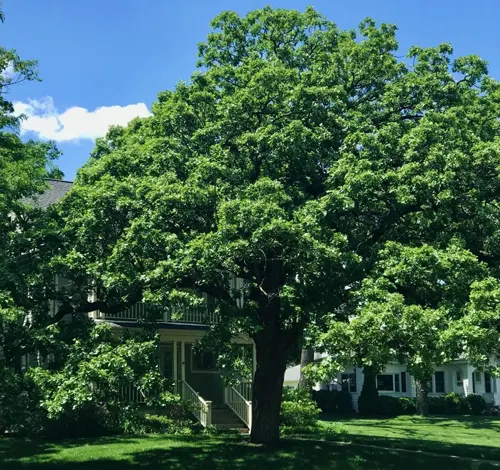
Factors to Consider Before Choosing a Tree
When planning to add a tree to your front yard, it’s important to take a few key factors into account to ensure that your new addition enhances your property both now and in the future.
- Size at Maturity: Firstly, consider the size of the tree at maturity. It’s easy to be charmed by a young sapling at the nursery, but it’s crucial to envision how large that tree will grow over the years. A tree that fits perfectly in your space now might, in a decade or two, grow large enough to interfere with power lines, obstruct views from windows, or even threaten the structural integrity of nearby buildings during storms. Researching the expected height and spread of the tree’s canopy at full maturity will help you avoid these potential issues. It’s important to ensure there’s enough room for the tree to grow to its full size without encroaching on your home, nearby structures, or overhead utilities.
- Root System: The tree’s root system is another vital consideration. Some species have invasive roots that can extend far beyond the tree’s canopy, potentially damaging sidewalks, driveways, or even the foundation of your house. Invasive roots can also interfere with underground utilities and plumbing. To prevent these problems, choose trees known for their less aggressive root systems, especially if you’re planting near structures or hardscaping. This foresight can save you from costly repairs and maintenance issues down the line.
- Climate and Soil Type: The climate and soil type of your area play a significant role in the health and growth of your tree. Not all trees are suited to all environments; a species that thrives in a cool, moist climate might struggle in a hotter, drier area. Before selecting a tree, research which species are native or well-adapted to your region’s climate. Native trees are often a good choice as they are naturally suited to the local conditions and usually require less maintenance. Additionally, understanding your soil type is crucial. Soil can vary greatly in terms of pH, nutrient levels, and drainage capabilities. Select a tree that will thrive in the conditions your yard can offer, considering factors like sun exposure, prevailing winds, and your area’s USDA hardiness zone.
- Maintenance Requirements: Lastly, think about the maintenance requirements of the tree you’re considering. Some trees need regular pruning to maintain their shape and health, while others might be more susceptible to pests and diseases, requiring ongoing attention and care. On the other hand, many species are known for their hardiness and low maintenance needs. Be realistic about how much time and effort you can dedicate to tree care. If your schedule is busy, or if you prefer a more hands-off approach to gardening, opting for a low-maintenance tree can ensure your landscape remains beautiful and manageable.
By taking these factors into account, you can select a tree that not only enhances the aesthetic appeal of your front yard but also thrives with minimal complications, making it a valuable addition to your property for many years to come.
Planting and Ongoing Care
When it comes to planting and caring for your newly chosen tree, proper techniques and ongoing attention are key to ensuring its health and longevity. Here’s a detailed guide to help you through the process:
Planting Tips
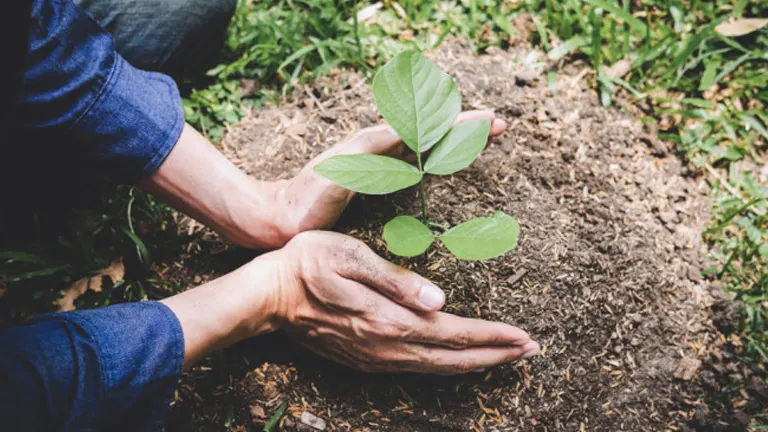
The way you plant your tree sets the stage for its future growth and health. Start by digging a hole that is twice as wide as the root ball of the tree but no deeper. This width encourages the roots to grow outward, establishing a strong foundation for the tree. When placing the tree in the hole, make sure that the top of the root ball is level with or slightly above ground level to prevent water from pooling around the base, which can lead to root rot. After placing the tree, backfill the hole with the same soil that was removed; amending the soil is not usually recommended as it can cause the roots to circle inside the hole rather than spreading into the surrounding soil. Gently tamp down the soil to eliminate air pockets and water thoroughly after planting to settle the soil.
Watering
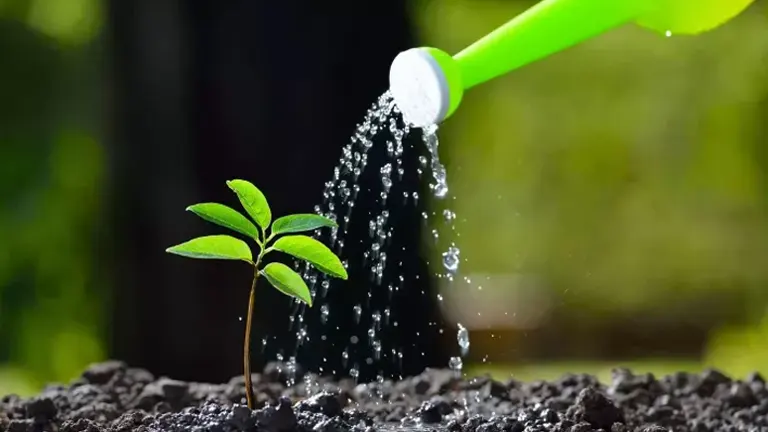
Proper watering is crucial, especially in the early stages of a tree’s life. Newly planted trees require more frequent watering to help establish their root systems. This typically means watering deeply once a week, allowing the moisture to reach the deeper roots. The goal is to encourage the tree to develop a deep, robust root system. As the tree becomes established, usually throughout one to two years, you can gradually reduce the frequency of watering. However, be mindful of the weather conditions and soil type; sandy soils and hot, dry weather will require more frequent watering compared to clay soils and cooler, moist climates.
Pruning
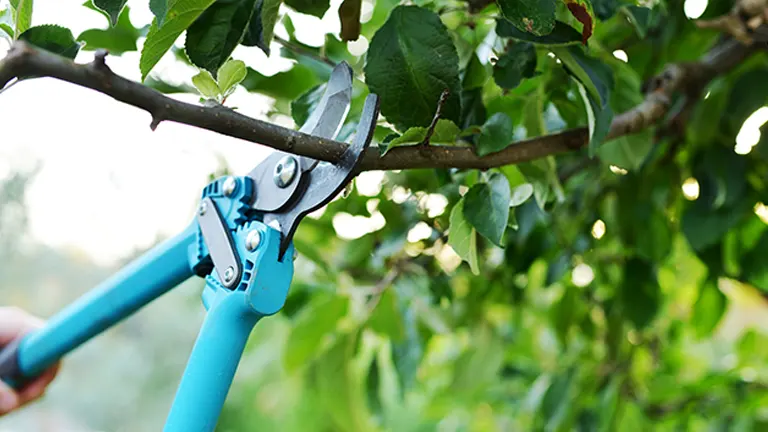
Pruning is essential for the health and aesthetic appeal of your tree. The best time to prune most trees is during their dormancy in late fall or winter. Pruning during this time minimizes sap loss and stress to the tree and reduces the risk of disease transmission. Remove any dead, damaged, or diseased branches, as well as any crossing or rubbing branches. Pruning should be done with a purpose – whether it’s to shape the tree, remove hazardous branches, or improve its structure. Remember to use clean, sharp tools to make clean cuts.
Disease Prevention
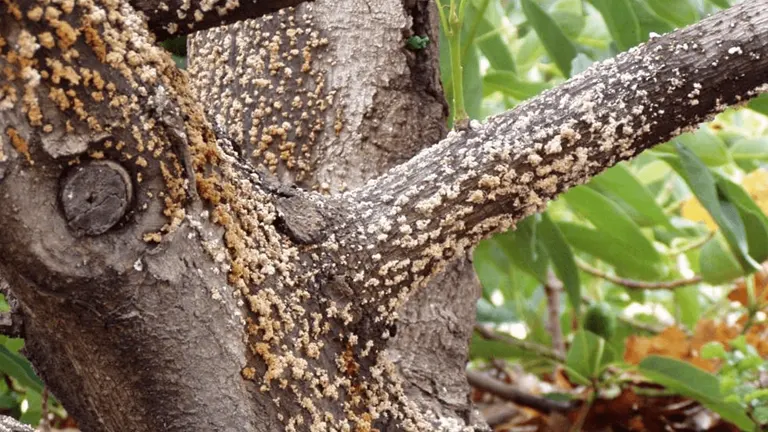
Regularly inspect your tree for signs of pests or disease. Early detection is crucial for effective management. Common signs include unusual leaf discoloration, dieback, deformed growth, or visible pests on the tree. If you notice any of these symptoms, consult with local arborists or extension services for a proper diagnosis and treatment options. They can offer advice specific to your tree species and local conditions. Additionally, maintaining the overall health of your tree through proper watering, mulching, and pruning can make it more resilient to pests and diseases.
Conclusion
Selecting the right tree for your front yard is a significant decision, that impacts both the aesthetics and health of your landscape. It’s important to consider factors like mature size, root behavior, and local climate and soil conditions. For tailored advice, consulting local gardening experts can be incredibly beneficial.
We also encourage you to share your own tree-planting experiences. Have you found a particular species that thrives in your front yard? Your insights and stories could provide invaluable guidance for others embarking on similar landscaping projects. Feel free to reach out and share your experiences or seek more personalized advice. Together, we can help each other cultivate beautiful, thriving outdoor spaces.
Related Articles:
- Best Tree for Privacy
- Best Trees for Indoors
- Best Small Trees for Your Front Yard
- Best Evergreen Trees for Privacy
FAQs
- Can trees increase my property value?
Absolutely! Studies have shown that well-placed, healthy trees can increase property values by as much as 20%. They enhance curb appeal and provide functional benefits like shade and privacy, which are attractive to potential buyers. - What’s a “secret” tree that not many people know about but is great for front yards?
One often-overlooked gem is the Amur Maple (Acer ginnala). It’s a smaller, hardy tree that offers stunning fall colors and can tolerate a range of soil conditions. Its modest size makes it perfect for smaller yards or as an underutilized accent tree. - Are there any trees I should avoid planting in my front yard?
It’s wise to avoid trees with invasive root systems, like the Silver Maple, or those prone to diseases, such as certain types of Ash trees that are susceptible to emerald ash borer. Also, steer clear of trees that drop messy fruits or nuts, which can be a nuisance in a yard. - How do I choose a tree that will look good all year round?
Opt for trees with multi-season interest. For example, the River Birch has peeling bark for winter interest, green foliage in summer, and yellow leaves in fall. Evergreens like the Blue Spruce also provide year-round color and structure. - Can planting the right tree lower my energy bills?
Yes, strategically placed trees can significantly reduce your energy bills. Deciduous trees planted on the south and west sides of a property can provide shade in the summer, reducing cooling costs, while allowing sunlight through in the winter for added warmth. - What’s the best tree for attracting wildlife to my yard?
Flowering trees like Crabapples or Serviceberries are excellent for attracting birds and pollinators. They provide nectar, fruits, and a habitat for various species, creating a vibrant and eco-friendly garden space. - Is there a fast-growing tree option for quick shade?
The Hybrid Poplar is known for its rapid growth, often adding several feet per year, making it a popular choice for quick shade. However, remember that fast-growing trees often have shorter lifespans and may require more maintenance.

David Murray
Forestry AuthorI'm David Murry, a forestry equipment specialist with a focus on chainsaw operation. With over 13 years of experience, I've honed my skills in operating and maintaining a wide range of machinery, from chainsaws to log splitters. My passion for the outdoors and commitment to sustainable forestry drive my work, which emphasizes safety, efficiency, and staying updated with industry advancements. Additionally, I'm dedicated to sharing my expertise and promoting environmental awareness within the forestry community.



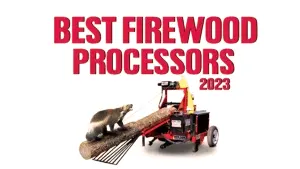









Leave your comment